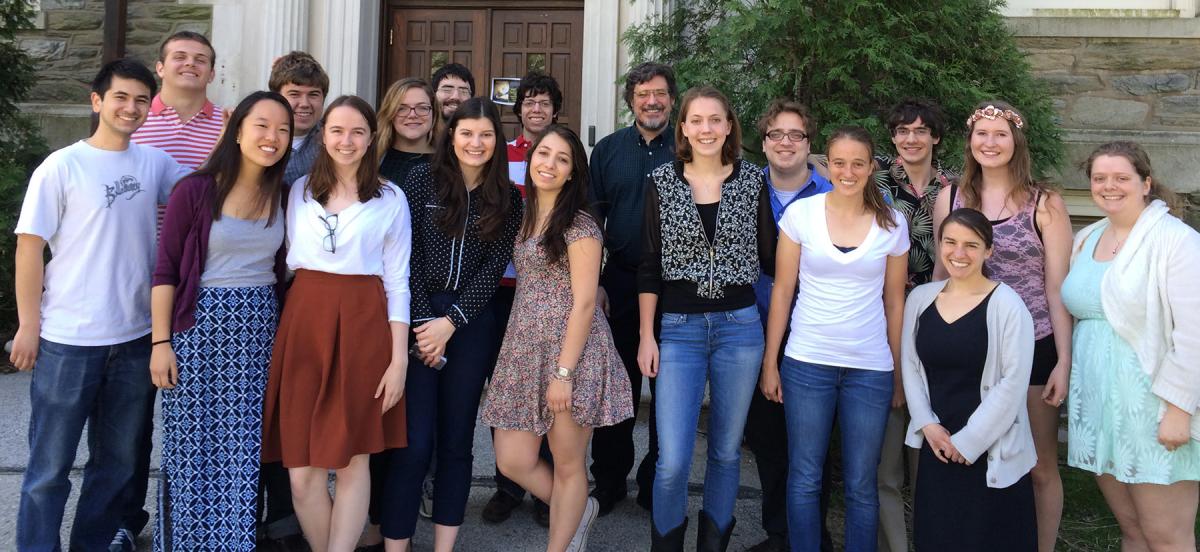The Class That Publishes Together

The 16 members of the 2015 "Biochemistry Superlab" course with their professors and co-authors, Rob Fairman (center) and Lou Charkoudian (third from right), in front of Sharpless.
Details
A "Biochemistry Superlab" course co-taught by Professor Rob Fairman and Assistant Professor Lou Charkoudian recently published a peer-reviewed paper in PLOS Biology detailing not only the results of in-class research, but also how the class itself was designed to facilitate such research.
There are many things a student can expect to take away from a science course at Haverford: an expanded interest in a subject, comfort with unfamiliar lab techniques or experimental approaches, mastery of key skills and theories. But a co-author credit on a scientific publication isn't usually one of them. For the 16 students in the inaugural "Biochemistry Superlab" course, however, that's exactly what they got.
"Uncovering protein-protein interactions through a team-based undergraduate biochemistry course," which was published in PLOS Biology in November 2017, featured contributions from every student in that 2015 class—David Cookmeyer '16, Emily Winesett '16, Sabina Aliev '16, Noah Bloch '16, Joshua Bulos '16, Irene Evans '16, Cristian Fagre '16, Kerilyn Godbe '16, Maryna Khromava '16, Daniel Konstantinovsky '16, Alexander Lafrance '16, Alexandra Lamacki '16, Robert Parry '16, Jeanne Quinn '16, Alana Thurston '16, and Kathleen Tsai '16—alongside those of their professors, Lou Charkoudian and Robert Fairman. In addition to its entire class of co-authors, the paper is noteworthy because it characterizes not just the results of their biochemistry research, but also how the class that undertook that research was taught and organized.
"Biochem Superlab," launched in 2015 by Charkoudian and Fairman and taught by other teams of two since then, integrates original research into the context of a junior-year biochemistry course. It was designed specifically to encourage students to generate their own hypotheses and create their own experiments to test them; there are no "canned" experiments with expected results for the students to perform, just an overarching question created by the two co-teaching professors to guide the research. Students from across the sciences take the class—with preference given to biochemistry concentrators—and professors from the Departments of Biology and Chemistry team-teach it, addressing interdisciplinary interests.
"The philosophy of 'Superlab' is that it gets students to think independently, critically, and creatively about projects in ways that then feed into teaching them how to do their own independent research, like the senior thesis," said Fairman, a professor of biology.
The professors treat their students like working scientists, demanding they conceive their own hypotheses and requiring them to practice communicating their findings via weekly group meetings, oral presentations, and the revision of manuscripts and proposals. Charkoudian and Fairman even offered networking opportunities for the students with professionals in the field.
"When reading a paper related to the project, we would actually invite the lead author in to come talk with the students," said Charkoudian, an assistant professor of chemistry, "and the students would interact with that person. We even had the class read about that person's background to see how they got from being a college student to where they are today."
The 2015 "Superlab" was focused on questions related to the reactions bacteria accelerate, or catalyze, to make molecules that humans use for pharmaceutical purposes—specifically in the interactions between enzymes that catalyze a reaction called "beta-hydroxylation."
"It only occurs at certain sites on the molecules, and we are interested in how the enzymes place the hydroxyl groups at the right sites," said Charkoudian. "We took the enzymes responsible for installing that hydroxyl group and the enzyme responsible for carrying the molecule, and were able to recreate the hydroxylation reaction. Then the students went in and they started to change things. They would mutate part of the protein, or they would change part of the molecule to see when the enzymes would stop functionally interacting with each other. They wondered, 'Are there specific protein interactions that will facilitate the reaction to occur?'"
The PLOS Biology paper covers these findings alongside a detailed account of how the class was structured and run, which is unusual. In the world of academic journals, there are those that specialize in scientific research and others that report on educational pedagogy, but rarely does one do both.
"We wrote to the editors in advance," said Charkoudian. "We said, 'We want to have a sort of hybrid narrative where we discuss both our research findings and the pedagogical findings under the umbrella of a single paper, would you be open to publishing to this sort of paper?' And we got the green light before submitting it."
In fact, co-authoring the paper as a class became an additional part of the students' scientific education.
"We’ve taken them all the way through the process of submitting an article, explaining the peer-review process, having all the students involved in reading those peer-review comments and helping us form a rebuttal letter and revise the manuscript," said Charkoudian. "So they really had the opportunity to 'peek beyond the curtains' and see how it all works."
"The teacher-scholar model, which consists of teaching and research is something I don’t think is valued as much as it should be," said Fairman, who hopes that the template laid out in their PLOS Biology paper will be replicated at other institutions. "We at Haverford value that, and I think we are looking to take a lead in the scientific community to make that part fully appreciated."



